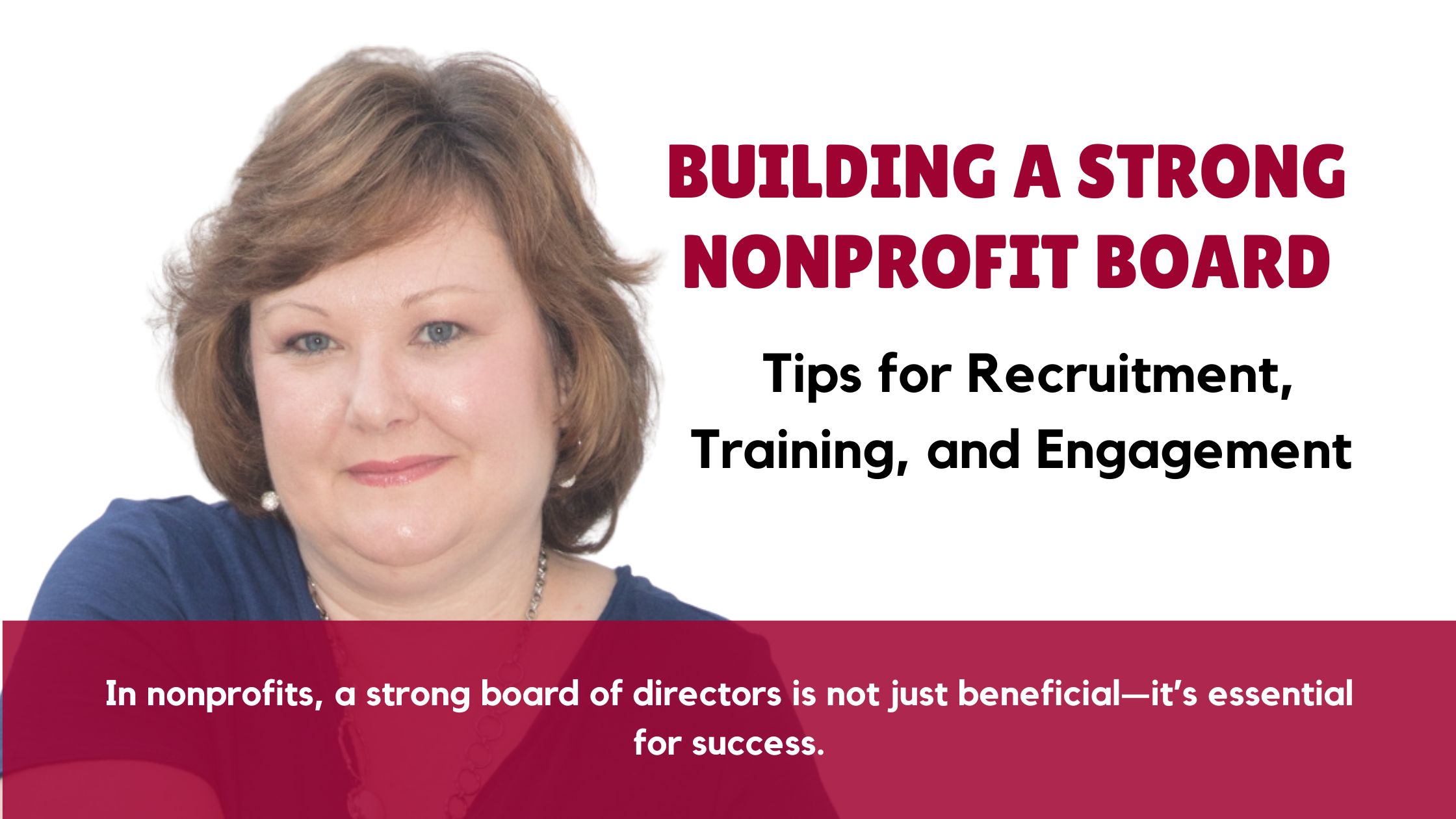Building a Strong Nonprofit Board: Tips for Recruitment, Training, and Engagement
In the world of nonprofits, a strong board of directors is not just beneficial—it’s essential for success. A well-organized, committed board can steer your organization toward achieving its mission and ensuring sustainability.
However, many nonprofit founders struggle to build such a board. Common challenges include finding qualified members, ensuring their engagement, and maintaining their commitment over time. These issues can hinder the organization’s progress and effectiveness.
This post will explore practical tips on recruiting, training, and engaging board members effectively. By implementing these strategies, you can build a board that not only supports but actively drives your nonprofit’s success.
The Role of the Board of Directors
A board of directors is a group of individuals elected to oversee a nonprofit organization’s activities and strategic direction. Their role is crucial as they provide governance, ensure accountability, and support the organization in achieving its mission.
Definition and Importance: The board of directors serves as the governing body of a nonprofit. They are responsible for setting policies, making significant decisions, and ensuring the organization remains true to its mission. A strong board provides credibility and stability, vital for attracting donors and partners.
Responsibilities:
- Governance: Establishing policies and ensuring the organization complies with legal and ethical standards.
- Strategic Planning: Setting the organization’s long-term goals and strategies.
- Fundraising: Supporting and participating in fundraising efforts to ensure financial sustainability.
- Financial Oversight: Monitoring the organization’s financial health, approving budgets, and ensuring resources are used effectively.
Impact: A strong board can significantly drive a nonprofit’s success. They bring diverse skills and perspectives, which help in making informed decisions and solving complex problems. Engaged and effective board members can open doors to new opportunities, enhance the organization’s reputation, and provide the leadership needed to achieve its mission.
In summary, the board of directors plays a foundational role in the health and success of a nonprofit, making their recruitment, training, and engagement paramount.
Recruiting the Right Board Members
Identifying Needs: The first step in recruiting effective board members is to assess the skills and expertise your board needs. Consider areas such as finance, law, marketing, and fundraising. A diverse board with various professional backgrounds can provide a broad range of insights and skills necessary for the nonprofit’s success. Conduct a skills gap analysis to determine what expertise is missing and what kind of individuals can fill those gaps.
Finding Candidates: Finding potential board members can be done through several strategies:
- Networking: Contact your professional and personal networks to find passionate individuals about your cause.
- Community Events: Attend community events, conferences, and industry meetups to connect with like-minded professionals.
- Online Platforms: Utilize platforms like LinkedIn, VolunteerMatch, and board-specific recruitment sites to find candidates looking for board opportunities.
- Referral Programs: Ask current board members, donors, and volunteers to recommend individuals they think would be a good fit.
Evaluating Candidates: Once you have a list of potential candidates, the next step is to assess them to ensure they align with your mission and values. Here are some tips:
- Interviews: Conduct thorough interviews to understand their motivations, commitment levels, and what they can bring to the board. Ask about their previous board experience, understanding of your nonprofit’s mission, and willingness to participate actively.
- References: Check references to understand their professional background and reliability better.
- Alignment with Values: Ensure that the candidates share your organization’s passion and values. This alignment is crucial for a cohesive and dedicated board.
By carefully identifying, finding, and evaluating potential board members, you can build a strong, effective board that will drive your nonprofit toward its mission and goals.
Orientation and Training
Initial Orientation: A thorough orientation process is crucial for new board members to understand the organization’s mission, goals, and operations. This orientation should cover the nonprofit’s history, current strategic plan, key programs and services, and board members’ roles and responsibilities. This helps new members hit the ground running and feel connected to the organization’s purpose from the start.
Ongoing Training: Continuous education opportunities are essential for keeping board members informed and engaged. Organize regular workshops, seminars, and retreats to provide updates on industry trends, new regulations, and best practices in nonprofit management. This ongoing training helps board members stay current and effectively contribute to the organization’s growth.
Resource Provision: Providing board members with the right resources is key to their success. Share handbooks, bylaws, strategic plans, financial reports, and meeting minutes. These resources ensure that board members have the information to make informed decisions and stay actively engaged in their roles.
By implementing a comprehensive orientation and ongoing training program, you can ensure your board members are well-prepared, knowledgeable, and fully equipped to support your nonprofit’s mission and goals.
Engaging and Retaining Board Members
Involvement in Decision-Making: Active participation in decision-making processes is vital for board member engagement. Involve your board in strategic planning, major organizational decisions, and policy development. This will not only utilize their expertise but also make them feel valued and integral to the nonprofit’s success.
Recognition and Appreciation: Regularly acknowledging the contributions of your board members fosters a positive and motivating environment. Publicly recognize their efforts through newsletters, social media, and events. Personal gestures like thank-you notes or awards can significantly boost morale and demonstrate genuine appreciation for their hard work and dedication.
Professional Development: Offering opportunities for professional growth is another key to retaining board members. Provide access to workshops, conferences, and networking events within the nonprofit sector. Encouraging board members to enhance their skills and expand their networks benefits them individually and brings fresh insights and ideas to your organization.
By actively involving board members in decision-making, regularly recognizing their contributions, and supporting their professional development, you can maintain a committed and motivated board that drives your nonprofit toward its mission.
Addressing Common Challenges
Board Dynamics: Managing conflicts and ensuring productive meetings are crucial for a harmonious and effective board. Establish clear communication channels and set ground rules for discussions. Encourage open dialogue and respect for diverse opinions. Facilitate team-building activities to strengthen relationships and foster a collaborative environment.
Commitment Issues: Keeping board members motivated and committed to their roles can be challenging. Regularly remind them of the organization’s mission and the impact of their work. Set clear expectations and provide meaningful tasks. Recognize their contributions and celebrate successes to keep their enthusiasm high.
Diverse Representation: A diverse board brings varied perspectives and skills, enhancing decision-making and innovation. Strive for diversity in ethnicity, gender, age, professional background, and personal experiences. Actively seek out and recruit individuals from underrepresented groups to ensure your board reflects the community you serve.
By effectively managing board dynamics, addressing commitment issues, and fostering diverse representation, you can overcome common challenges and build a stronger, more effective board that drives your nonprofit’s success.
Conclusion
In this post, we’ve explored the key strategies for building a strong nonprofit board, including recruiting the right members, providing thorough orientation and ongoing training, engaging and retaining members, and addressing everyday challenges. By implementing these strategies, you can create a board that drives your organization toward success.
For more detailed guidance and actionable steps, consider purchasing my book, “I HAVE MY 501(C)3! NOW WHAT?!?”.
📘 Get your copy today! 📘
I’d love to hear about your experiences and answer any questions you have about building a strong board. Share your thoughts in the Facebook group, Nonprofit Founder’s Club!

